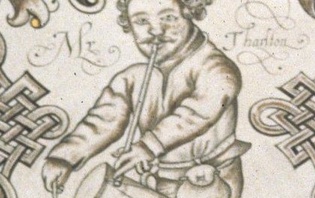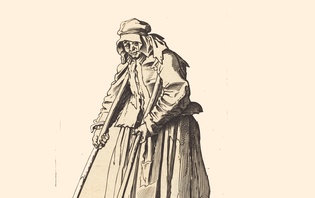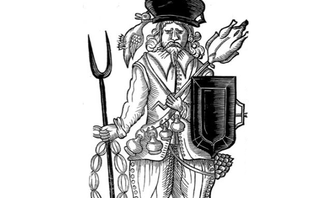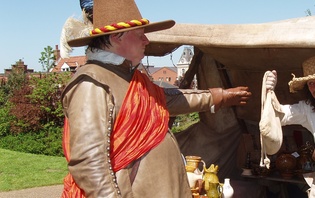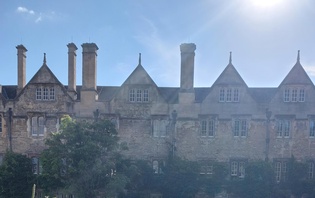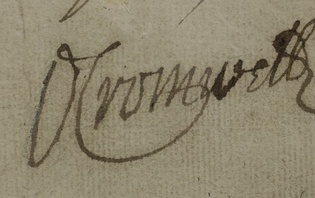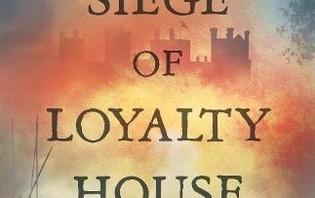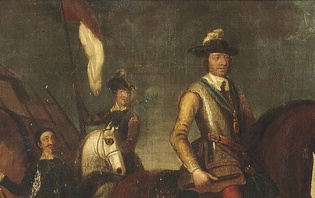Echoes of a Massacre: The Petition of Bridget Rumney
The massacre of the royalist camp-followers in Farndon Field following the battle of Naseby was one of the most notorious incidents in the English Civil Wars and a subject of intense debate since. At the heart of this debate lies an uncertainty as to the identity of the unfortunate victims. However, in this week’s blog, Mark Stoyle reveals the identity of one family group present on that fateful day. This discovery has been made possible by a petition addressed to Charles II in May 1660, the contents of which remind us that women and children could be as much at risk from the dangers of war as the combatants who fought in the conflict.
On 14 June 1645, parliament’s New Model Army, under the command of Sir Thomas Fairfax, Oliver Cromwell and Philip Skippon, utterly defeated Charles I’s main field army at the battle of Naseby. As every history of the Civil War attests, it was a decisive engagement: one which resulted in the destruction of the king’s veteran infantry force, the flight of his cavalry and the capture of his baggage-train, together with all of his personal correspondence. What is too often forgotten is that the battle of Naseby also resulted in perhaps the single worst atrocity of the Civil War in England, for, as the victorious Parliamentarian soldiers pursued their beaten enemies from the field, they fell upon the king’s female camp-followers, who, having seen that the day was lost, had set off in headlong flight towards the royalist garrison at Leicester. According to a later account, the parliamentarian troopers caught up with the terrified fugitives ‘in the south part of Farndon-field, within the gate place in the road between Naseby and Farndon’. Here a dreadful slaughter ensued, as the soldiers set about the Royalist women with their swords, killing at least a hundred of them, and savagely mutilating many more. In the aftermath of the battle, parliamentarian pamphleteers in London made no apology for what their soldiers had done, but rather triumphed in their murderous actions: some claiming that the killed and injured women had been ‘whores’, others that they had been Irish women, ‘wives of the bloody rebells in Ireland’, who had – according to earlier, exaggerated, accounts – slain thousands of Protestant men and women during the Irish Rebellion of 1641.
The reports which appeared in the London press in the immediate aftermath of the battle are the chief surviving sources for the acts of butchery which were perpetrated in Farndon Field and, as a result, it is through the lens of these – highly partisan – reports that the victims of the massacre have tended to be viewed ever since. That many of the parliamentarian soldiers who took part in the attack genuinely believed the women who accompanied the royalist army to be a horde of sexually immoral ‘courtesans’, interspersed with companies of knife-wielding ‘Irish-sluts’ and even the occasional ‘witch’, is easy to credit; this was, after all, what their own propagandists in London had been affirming in print almost from the moment that the conflict began. Yet, clearly, we cannot assume that such tendentious reports painted a wholly accurate picture of the women who marched in the king’s train – while the fact that one of the few royalist sources to allude to the massacre describes those who were killed as ‘women and soldiers’ wives’ strongly suggests that, while some of the luckless individuals who were cut down by the Parliamentarian troopers may, indeed, have been ‘common women’, or prostitutes, many entirely ‘respectable’ women were slaughtered as well.
Little evidence has survived about the individual women who suffered at Naseby, though we do catch just an occasional glimpse of them in the historical record. On 1 July 1645, for example, the parish clerk of Kidderminster, near Worcester, recorded the burial of ‘a woman … wounded at the battle in Leicestershire’. Almost certainly, this was one of the king’s camp-followers who had been injured at Naseby, but who had nevertheless managed to escape from the battlefield and to flee towards the West alongside the rest of the broken royalist forces, only to die – whether of her wounds, of illness, or of simple exhaustion – a fortnight later. Yet, poignant as this brief record is, it tells us next to nothing about the flesh-and-blood woman for whom it now stands as the sole surviving epitaph. Altogether more revealing is a document preserved among the State Papers, which permits us to rescue one of the women who perished at Naseby from the anonymity which has cloaked the victims of the massacre hitherto – and, in the process, to subvert the London pamphleteers’ representation of them as a mere ‘rabble’ of violent and licentious individuals.
In May 1660 a certain Bridget Rumney submitted a petition to the newly-restored King Charles II in which she begged that she herself might be ‘restowred’ to the position at Court which she had enjoyed during the reign of his father. Rumney began by explaining that she and her mother, Elizabeth Burgess, had long been members of the royal household, and, more specifically that they had ‘bin servants to your Gracious Majesty’s late Grandfather [i.e. James I and VI] and father [i.e. Charles I] … in the Office for providing of flowers and sweete herbes for the Court’. In proof of her claim that she had been appointed to this office – the chief duty of which was to strew sweet-smelling flowers and herbs around the royal lodgings – in succession to her mother, Rumney enclosed a certificate signed by one Peter Newton, a former household servant to Charles I. ‘These are to certifie’, Newton’s note ran: ‘that by virtue of a warrant to mee directed, from the kings … majesty, I have sworn the bearer hereof, Bridget Rumney, garnisher and trimmer of the [royal] Chapple, Presence and Privy Lodgings, in the roome of Elizabeth Burgess hir mother, deceased, to hould and enjoy the same with all fees and profits thereto belonging’. The fact that this certificate is dated 11 September 1647 makes it clear that Rumney had succeeded to her mother’s position at a time when Charles I had been living in distinctly reduced circumstances following his defeat in the Civil War: at his palace of Hampton Court, certainly, but by now in the custody of the victorious New Model Army. Within a year and a half of Rumney’s having been sworn in, the king had met his death upon the scaffold at Whitehall, so Bridget can have had little time to enjoy her new position.
This misfortune was by no means the worst that Rumney had had to suffer in her life, however, for, as her post-war petition makes clear, she had only succeeded to her mother’s office in the first place as the result of a family tragedy. For ‘soe yt is’, she sorrowfully informed Charles II in 1660, ‘that your petitioner’s poor mother and two of your petitioner’s sons were slayne at Nazebie’. Rumney’s testimony is fascinating: first, because it permits us to identify Elizabeth Burgess as having been, almost certainly, one of the victims of the Naseby massacre, and second because it allows us to see that – far from having been one of ‘the harlots with golden tresses’ of the London pamphleteers’ fevered imaginations – this particular victim of the Parliamentarian soldiers’ rage had in fact been a domestic servant of relatively advanced years, whose chief occupation before the outbreak of the conflict had been the scattering of flowers and herbs around the royal court.
Rumney’s bleak, matter-of-fact statement about the death of her mother and her two sons raises all sorts of unanswerable questions. What had Burgess been doing in the king’s train during the fateful summer of 1645, for example? Had she been continuing to carry out her pre-war duties at the peripatetic court which sprang up in the field wherever Charles I halted as he marched across the countryside on campaign? Or had she had been acting in some other domestic role in the royalist baggage-train, after having gravitated to the king’s army as a place of continued employment and refuge following Charles I’s enforced departure from his palace at Whitehall in 1642? Was Bridget Rumney with her mother on the day that the latter was killed? And what of Rumney’s two sons? Had they been young men serving in the Cavalier army? Or had they been mere boys, fleeing alongside their grandmother – and their mother, too, perhaps – as the troopers bore down on the terrified throng of civilians streaming along the road from Naseby to Farndon? We cannot know – although the fact that Rumney stated in her later petition that she had been left with ‘six smale children’ after her mother’s death hardly suggests that her two ‘slayne’ sons can have been very old.
It is pleasant to be able to record that Rumney’s plea that her old office should be restored to her was granted by Charles II – and that she continued to serve as his official ‘Herb-woman’ throughout the 1660s, receiving the handsome salary of £24 per annum for her pains. The relief of securing a permanent post at court again, together with all of the financial and social benefits it brought, must surely have done something to assuage Rumney’s pain over the triple bereavement which she had suffered during the Civil War. It is hard to believe that she can ever have forgotten that conflict, though – or the terrible fate which had befallen her sons, her mother and so many other non-combatant women in the wake of what one contemporary writer aptly termed ‘the battle of Dreadful Down’.
Suggestions for further reading:
Glenn Foard, Naseby: The Decisive Campaign (Whitstable, 1995).
Ann Hughes, Gender and the English Revolution (Abingdon, 2012).
Mark Stoyle, ‘The Road to Farndon Field: Explaining the Massacre of the Royalist Women at Naseby’, The English Historical Review, volume 123 (August 2008), pp. 895-923.

